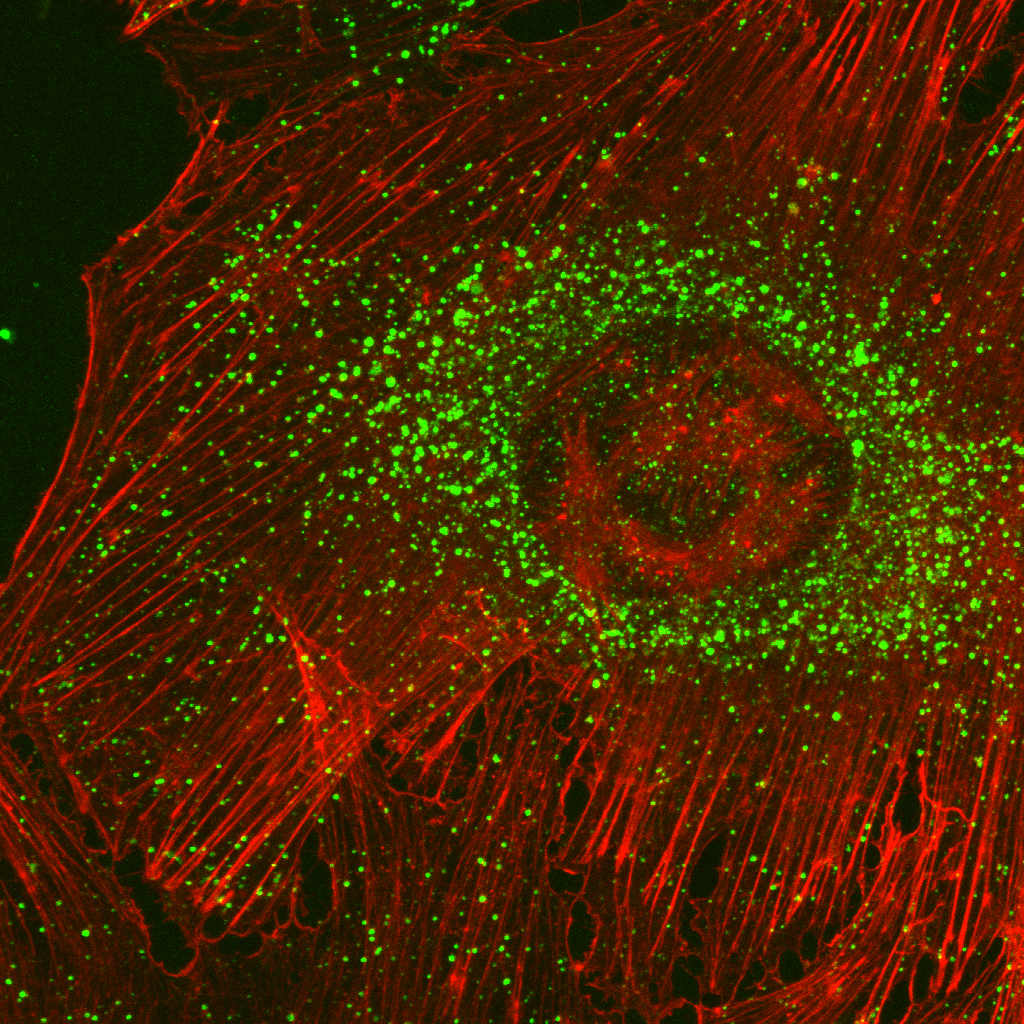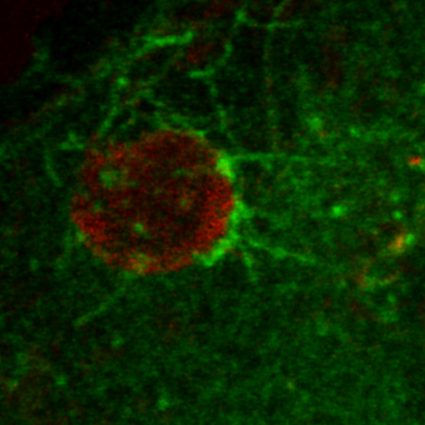The highly co-ordinated movement of the thousands of distinct membrane proteins between the cell surface and intracellular compartments is a critical factor in health and disease. This movement controls the organisation of cells in tissues and communication between cells and their environment. The success of this process depends on the regulated sorting and trafficking of proteins within the highly dynamic endosomal compartments of the cell in processes that are emerging as important drivers of neurodegenerative disease, cancer and metabolic pathologies. An understanding of how endosomal traffic is regulated, and how lysosomal traffic and degradation are modulated, is critical for providing insights into disease and devising new therapeutic approaches.
- Chen KE, Guo Q, Hill TA, Cui Y, Kendall AK, Yang Z, Hall RJ, Healy MD, Sacharz J, Norwood SJ, Fonseka S, Xie B, Reid RC, Leneva N, Parton RG, Ghai R, Stroud DA, Fairlie DP, Suga H, Jackson LP, Teasdale RD, Passioura T, Collins BM. De novo macrocyclic peptides for inhibiting, stabilizing, and probing the function of the retromer endosomal trafficking complex. Science Advances. (2021) 7 eabg4007.
- Cui Y, Yang Z, Flores-Rodriguez N, Follett J, Ariotti N, Wall AA, Parton RG, Teasdale RD. Formation of retromer transport carriers is disrupted by the Parkinson disease-linked Vps35 D620N variant. Traffic. (2021) 22 123-136.
- Yang Z, Li Z, Teasdale RD Retromer dependent changes in cellular homeostasis and Parkinson's disease. Essays in Biochemestry. (2021) 65 987-998
- Cui Y, Carosi JM, Yang Z, Ariotti N, Kerr MC, Parton RG, Sargeant TJ, Teasdale RD Retromer has a selective function in cargo sorting via endosome transport carriers. Journal of Cell Biology. (2019) 218 615-631.
- Kovtun O, Leneva N, Bykov YS, Ariotti N, Teasdale RD, Schaffer M, Engel BD, Owen DJ, Briggs JAG, Collins BM. Structure of the membrane-assembled retromer coat determined by cryo-electron tomography. Nature. (2018) 561 561-564.
- Kerr MC, Gomez GA, Ferguson C, Tanzer MC, Murphy JM, Yap AS, Parton RG, Huston WM, Teasdale, R.D. Laser-mediated rupture of chlamydial inclusions triggers pathogen egress and host cell necrosis. Nature Communications (2017) 8 14729.
- Yang Z, Hong LK, Follett J, Wabitsch M, Hamilton NA, Collins BM, Bugarcic A, Teasdale, R.D. Functional characterization of retromer in GLUT4 storage vesicle formation and adipocyte differentiation. FASEB Journal (2016) 30 1037 – 1050.
- Follett J, Bugarcic A, Yang Z, Ariotti N, Norwood SJ, Collins BM, Parton RG, Teasdale, R.D. Parkinson Disease-linked Vps35 R524W Mutation Impairs the Endosomal Association of Retromer and Induces α-Synuclein Aggregation. Journal of Biological Chemistry (2016) 291 18283 – 18298.
- Follett J, Norwood SJ, Hamilton NA, Mohan M, Kovtun O, Tay S, Zhe Y, Wood SA, Mellick GD, Silburn PA, Collins BM, Bugarcic A, Teasdale, R.D. The Vps35 D620N Mutation Linked to Parkinson's Disease Disrupts the Cargo Sorting Function of Retromer. Traffic (2014) 15 230 – 244.
- Kerr M., Teasdale, R.D. Live imaging of endosome dynamics. Seminars In Cell and Developmental Biology (2014) 31 11 – 19.
- Teasdale, R.D. and Collins, B.C. Insights into the PX (phox-homology) domain and SNX (sorting nexin) protein families: structures, functions and roles in disease. Biochemistry Journal (2012) 441 39 – 59.
- Bugarcic A., Zhe Y., Kerr M.C., Griffin J., Collins B.M., and Teasdale, R.D. Vps26A and Vps26B Subunits Define Distinct Retromer Complexes. Traffic (2011) 12 1759 – 1773.
- Kerr M.C., Wang, J.T.H., Castro, N., Hamilton, N.A., Town, L., Brown, D.L., Meunier, F.A., Brown, N.F., Stow, J.L. and Teasdale, R.D. Inhibition of the PtdIns(5) kinase PIKfyve disrupts intracellular replication of Salmonella. The EMBO Journal (2010) 8 295 1331 – 1347.
- Wang J.T., Kerr M.C., Karunaratne S., Jeanes A., Yap A.S., and Teasdale, R.D. The SNX-PX-BAR family in macropinocytosis: the regulation of macropinosome formation by SNX-PX-BAR proteins. PLoS One (2010) 5 e13763 -.
- Kerr M.C., and Teasdale, R.D. Defining macropinocytosis. Traffic (2009) 10 364 – 371.
- Fink, J.L., Karunaratne, S., Mittal, A., Gardiner, D., Hamilton, N., Mahony,D., Kai, C., Suzuki, H., Hayashizaki, Y. and Teasdale, R.D. Towards defining the nuclear proteome. Genome Biology (2008) 9 R15 -.
- Kerr, M.C., Bennetts, J.C., Simpson, F., Thomas, E.C., Flegg, C., Gleeson, P.A, Wicking, C., and Teasdale, R.D. A Novel Mammalian Retromer Component, Vps26B. Traffic (2005) 6 991 – 1001.
- Teasdale, R.D., Loci, D., Karlsson, L. and Gleeson, P.A. A large family of endosomal localised proteins related to sorting nexin 1. Biochemical Journal (2001) 358 7 – 16.
To view the full publications, visit the links below:
Find out more about our diverse range of research interests.

 Fidelity of transport through the endosomal system requires mechanisms that precisely sort cargoes for delivery to a range of different destinations. This is achieved by cargo engaging specific sorting machinery that is responsible for their accumulation into tubules that then undergo scission to generate endosome-transport carriers (ETCs). Once formed, these carrier vesicles engage the machinery at the target membrane, resulting in cargo delivery to the specific membrane, e.g. plasma membrane. Retromer has been identified to have a central role in this process and it is the spatial and temporal coordination of the interaction between Retromer and associated proteins that determines the properties of the individual endosome-transport carriers formed. We are currently investigating the contribution each of the variant Retromer complexes has on the formation of the distinct endosome-transport carrier types and to the sorting of a range of cargo actively transported by these vesicles.
Fidelity of transport through the endosomal system requires mechanisms that precisely sort cargoes for delivery to a range of different destinations. This is achieved by cargo engaging specific sorting machinery that is responsible for their accumulation into tubules that then undergo scission to generate endosome-transport carriers (ETCs). Once formed, these carrier vesicles engage the machinery at the target membrane, resulting in cargo delivery to the specific membrane, e.g. plasma membrane. Retromer has been identified to have a central role in this process and it is the spatial and temporal coordination of the interaction between Retromer and associated proteins that determines the properties of the individual endosome-transport carriers formed. We are currently investigating the contribution each of the variant Retromer complexes has on the formation of the distinct endosome-transport carrier types and to the sorting of a range of cargo actively transported by these vesicles. Our research into defining the composition of a mammalian endosomal protein complex, termed Retromer, has made major contributions to its recent emergence as a central, critical regulator of early endosome protein trafficking. Recently, pathogenetic mutations within a Retromer subunit, Vps35, have been directly associated with causing late onset Parkinson’s disease. More broadly, endosomes are emerging to have a central role in the pathobiology of neurodegenerative diseases, including Alzheimer’s & Parkinson’s diseases.
Our research into defining the composition of a mammalian endosomal protein complex, termed Retromer, has made major contributions to its recent emergence as a central, critical regulator of early endosome protein trafficking. Recently, pathogenetic mutations within a Retromer subunit, Vps35, have been directly associated with causing late onset Parkinson’s disease. More broadly, endosomes are emerging to have a central role in the pathobiology of neurodegenerative diseases, including Alzheimer’s & Parkinson’s diseases. Adipose tissue, commonly referred to as fat, influences the function of nearly all other organ systems through secretion of a diverse range of metabolites and peptide hormones. In a nutrient-rich or fed state, high levels of insulin bind to its receptor on adipocytes and the resulting cell signaling events cause the translocation of GLUT4-specialised vesicles (GSV) to the plasma membrane. This results in an increased glucose uptake via the GLUT4 transporter. The formation of GSVs within adipocytes represents an important part of this interconnected metabolic system and is critical for its regulation. Using a series of novel cell line and mouse models, we are examining the contribution Retromer-dependent endosome protein sorting and formation of endosome-transport carriers has on the generation of GSVs in adipocytes and its impact on adipocyte biology within whole animal models.
Adipose tissue, commonly referred to as fat, influences the function of nearly all other organ systems through secretion of a diverse range of metabolites and peptide hormones. In a nutrient-rich or fed state, high levels of insulin bind to its receptor on adipocytes and the resulting cell signaling events cause the translocation of GLUT4-specialised vesicles (GSV) to the plasma membrane. This results in an increased glucose uptake via the GLUT4 transporter. The formation of GSVs within adipocytes represents an important part of this interconnected metabolic system and is critical for its regulation. Using a series of novel cell line and mouse models, we are examining the contribution Retromer-dependent endosome protein sorting and formation of endosome-transport carriers has on the generation of GSVs in adipocytes and its impact on adipocyte biology within whole animal models.

